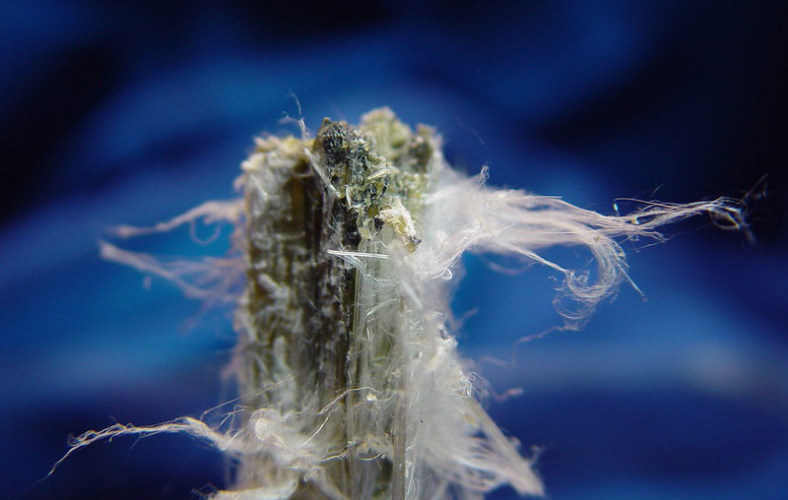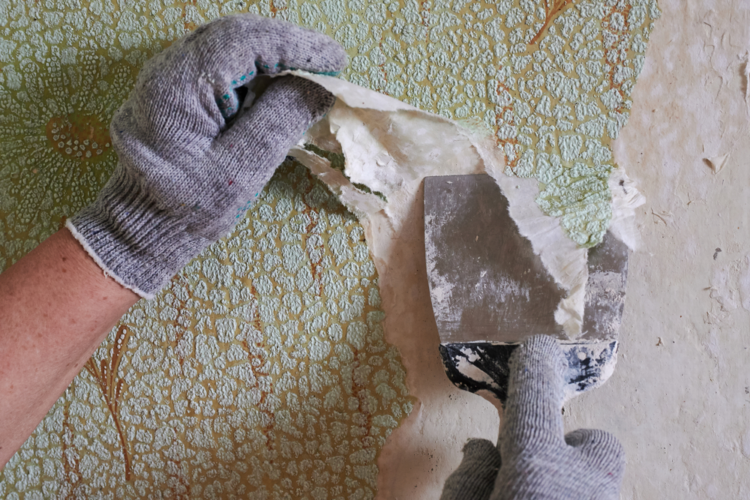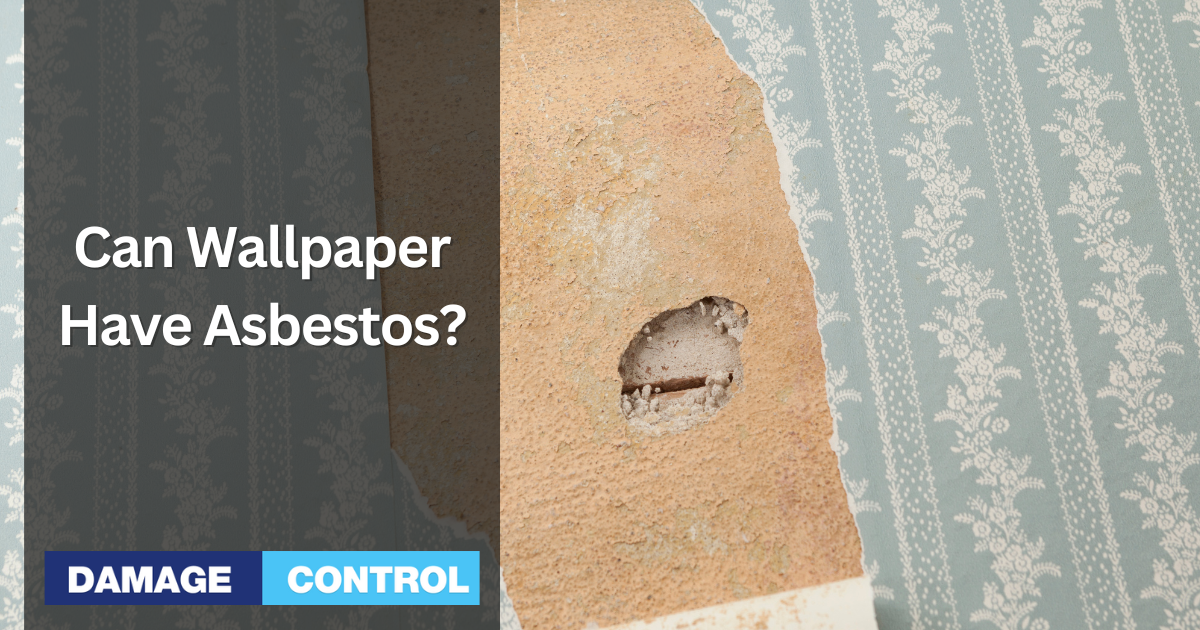It's a question many homeowners ponder: “Can wallpaper contain asbestos?” It absolutely can contain asbestos depending on when it was made. Let's dive deep and understand the association between wallpaper and asbestos.
A Glimpse Into Asbestos

To begin with, asbestos is a naturally occurring mineral mined from the earth. It possesses several notable properties such as fire resistance, which elevated its demand in various products. Its inherent toughness speaks to its durability, and its insulation capabilities ensure that it can regulate temperatures, either preserving warmth or maintaining coolness.
Historically, these attributes made asbestos a sought-after component in a myriad of products, especially building materials.
Wallpaper's Connection
Wallpaper, a common decorative element, has evolved over the decades. As home aesthetics transitioned, so did the materials used in wallpaper. In a time spanning from the roaring 1920s to the transformative 1970s, an unexpected component often made its way into these wall adornments: asbestos.
But why, you might wonder, was asbestos ever considered for something as innocuous as wallpaper? The answers are multifaceted.
Strength and Durability
Wallpaper wasn't merely a decorative piece; it was also an investment. Homeowners sought wallpapers that would last, resisting tears and wear over time. Asbestos, known for its robust nature, granted wallpaper a superior lifespan.
Unique Texture
In an era when the aesthetics of a home played a pivotal role, the grainy, unique texture asbestos offered was a valued feature. This roughness, imparted by asbestos, gave certain wallpapers a distinct look, often preferred by those desiring a break from the norm.
Fire Resistance
Safety, naturally, was paramount. Wallpapers, especially those placed near stoves, fireplaces, or radiators, faced a fire risk. Asbestos provided a solution. With its fire-resistant properties, it reduced the chance of wallpaper catching fire, offering homeowners peace of mind.
However, a crucial note to remember: not every wallpaper from this timeframe housed asbestos. While many did integrate this mineral, several opted for other materials. Yet, due to the significant number that did incorporate asbestos, awareness and caution are imperative for those living in or renovating older homes.
The Risks Involved

Asbestos, once hailed for its myriad of benefits in construction, has now become synonymous with health hazards. But why the change in perspective? Let's unravel the concerning ties between asbestos and health.
Airborne Threat
Asbestos, at its core, comprises tiny fibers. While embedded securely within a product, they pose minimal risk. However, trouble brews when these fibers are disturbed. Activities like drilling, breaking, or even aggressive cleaning can set them free. Once airborne, they linger, invisible to the naked eye but ever-present, waiting to be inhaled.
The Perils of Inhalation
When these microscopic fibers find their way into our respiratory system, they become uninvited tenants. Unlike most particles we might accidentally breathe in, asbestos fibers don't easily break down or get expelled. They settle in, clinging to the lung tissues. Over time, this accumulation spells bad news for respiratory health.
Cumulative Health Effects
One-time exposure might not ring immediate alarm bells. However, repeated encounters or prolonged exposure amplify the risks exponentially. The lodged fibers can lead to inflammation, scarring, and eventually, more serious conditions.
Diseases like asbestosis, a chronic lung condition, and mesothelioma, a rare form of lung cancer, are directly linked to asbestos exposure. Beyond the lungs, asbestos fibers can also affect the lining of the chest and abdomen.
Given this intricate web of health concerns, a moment of reflection is crucial for homeowners with properties hailing from the asbestos era. If your home whispers tales from the past decades and a makeover is on the horizon, pause.
Remember the hidden potential of asbestos. This isn't an advocacy for fear but for informed caution. Approach renovations with knowledge, respect for the past, and a keen eye on safeguarding the future.
Identifying Asbestos in Wallpaper

When attempting to figure out if your wallpaper might be one of the many that contained asbestos during its prime usage years, there are a few key indicators to consider.
Age of the Property
The chronology of construction or renovation can be a telling sign. Homes that witnessed their genesis or a significant overhaul between the 1920s and 1970s fall into a bracket where asbestos use was prevalent. Thus, if your dwelling resonates with this timeline, it's wise to approach any renovation projects or redecorations with a heightened sense of vigilance.
The Look and Feel
Wallpapers from that era, which incorporated asbestos, often flaunt a distinctive texture. If you run your fingers along the surface and sense a rough or grainy consistency, it might raise an eyebrow. This unique texture, often sought for its aesthetic appeal back in the day, can now serve as a subtle alarm bell for potential asbestos presence.
Consulting the Experts
Guesswork has no place when health is at stake. While age and appearance can provide initial clues, the definitive answer lies in professional testing. Certified asbestos inspectors possess the tools and know-how to detect the presence of this mineral safely and accurately. When in doubt, their expertise should be your first port of call.
Amidst this investigative zest, a word of caution is paramount. If you harbor suspicions about your wallpaper containing asbestos, resist the urge to scratch, tear, or puncture it.
Disturbing such surfaces can release harmful asbestos fibers into the air, posing a health risk to the inhabitants. Instead, maintain its integrity and summon professionals to conduct a safe and thorough assessment. Your home's aesthetics are important, but your well-being and that of your loved ones? Priceless.
What to Do Next?
Finding asbestos in your home can be alarming, especially in places you least expect, such as your wallpaper. However, reacting in a calm and informed manner can ensure the safety of your household.
Upon discovering that your wallpaper contains asbestos, your first instinct might be fear or concern. It's essential to understand that undisturbed and intact asbestos materials generally do not release harmful asbestos fibers into the air. It becomes hazardous when it's damaged, deteriorating, or disturbed.
Leave It Alone
Intact Condition
If your wallpaper is in good condition, without visible tears, bubbles, or other damage, the asbestos fibers are likely contained and not currently a risk.
Avoid Disturbance
Refrain from drilling, nailing into, or doing anything that might disturb the wallpaper's surface. The more it's left alone, the lesser the risk of releasing asbestos fibers.
Limit Access
If possible, limit the amount of activity in the room where the asbestos-containing wallpaper is present. This further minimizes potential disturbances.
Professional Removal
Expertise Required
If you decide to remove the wallpaper, it's imperative to avoid DIY methods. Asbestos fibers are microscopic and can easily become airborne if not handled correctly.
Licensed Removalists
Always opt for professionals who are licensed for asbestos removal. They are trained to handle and dispose of asbestos-containing materials safely.
Safety Protocols
A licensed removalist will have the necessary equipment and follow strict safety guidelines to ensure minimal exposure and prevent contamination of your home.
Stay Informed
Routine Inspections
Even if the wallpaper is in good condition now, it's crucial to regularly inspect it for any signs of wear and tear or damage.
Educate Yourself
The more you know about asbestos, its risks, and safe handling practices, the better prepared you'll be to deal with any situations that might arise. Many local health departments and environmental agencies offer resources and guidance on asbestos in homes.
Have a Plan
If your wallpaper does become damaged, know the steps to take. This might include sealing off the room, avoiding any air circulation (like from fans or HVAC systems), and contacting a professional immediately.
Remember: Asbestos in its undisturbed form isn't necessarily a direct threat. It's the airborne fibers that pose risks when inhaled. Always prioritize safety, and when in doubt, consult with professionals.
A Shift in Perspective
Today, with stricter regulations, the chances of finding asbestos in modern wallpapers are slim. However, being aware of its presence in older homes is key. As always, knowledge is power. When you know what you're dealing with, you can make the best decisions for your home and family.
In Conclusion
Can wallpaper have asbestos? Yes, especially in older homes. But understanding the history, risks, and ways to deal with it can make all the difference. Always prioritize safety. And if in doubt, always consult an expert. Your home should be a haven, not a hazard. Safe decorating!

